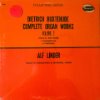Album Only List  view
view
 1993 - Abendmusik
1993 - Abendmusik
 1993 - Complete Organ Works, Volume 7
1993 - Complete Organ Works, Volume 7
 1992 - Schnitgerorgel der AA-kerk Groningen / Christiaan Teeuwsen
1992 - Schnitgerorgel der AA-kerk Groningen / Christiaan Teeuwsen
 1992 - Alles, was ihr tut
1992 - Alles, was ihr tut
 1991 - Complete Organ Works, Volume 4
1991 - Complete Organ Works, Volume 4
 1991 - Sound of Silesian Organs
1991 - Sound of Silesian Organs
 1991 - Buxtehude: Membra Jesu nostri / Schütz: O bone Jesu
1991 - Buxtehude: Membra Jesu nostri / Schütz: O bone Jesu
 1990 - German Harpsichord Music Before Bach
1990 - German Harpsichord Music Before Bach
 1989 - Dietrich Buxtehude
1989 - Dietrich Buxtehude
 1988 - L'Oeuvre d'Orgue
1988 - L'Oeuvre d'Orgue
 1988 - Kammermusik / Chamber Music / Musique de chambre
1988 - Kammermusik / Chamber Music / Musique de chambre
 1987 - Complete Organ Works, Volume 1
1987 - Complete Organ Works, Volume 1
 1981 - Deutsche Kammermusic vor Bach
1981 - Deutsche Kammermusic vor Bach
 1975 - Kompositionen für Altus
1975 - Kompositionen für Altus
Members
 1 Male
1 Male
Origin
 Deutch
Deutch
Genre
 Composer
Composer
Style
 Classical
Classical
Mood
---
Born
Origin
Genre
Style
Mood
---
Born
![]() 1637
1637
Active![]() ---
---![]() 1707
1707
Cutout![]()
No loved tracks found...
Artist Biography
Available in:
Dieterich Buxtehude (German: 1637/39 – 9 May 1707) was a Danish-German organist and composer of the Baroque period. His organ works represent a central part of the standard organ repertoire and are frequently performed at recitals and in church services. He composed in a wide variety of vocal and instrumental idioms, and his style strongly influenced many composers, including Johann Sebastian Bach. Today, Buxtehude is considered one of the most important composers in Germany of the mid-Baroque.
Early years in Denmark :
Memorial plaque at Buxtehude House in Helsingør
This is Buxtehude House. The spire of St. Olaf's is in the background.
He is thought to have been born with the name Diderich Buxtehude. His parents were Johannes (Hans Jensen) Buxtehude and Helle Jespersdatter. His father originated from Oldesloe in the Duchy of Holstein, which at that time was a part of the Danish Monarchy (but is now in Germany). Scholars dispute both the year and country of Dieterich's birth, although most now accept that he was born in 1637 in Helsingborg, Skåne, at the time part of Denmark (but now part of Sweden). His obituary stated that "he recognized Denmark as his native country, whence he came to our region; he lived about 70 years". Others, however, claim that he was born at Oldesloe. Later in his life he Germanized his name and began signing documents Dieterich Buxtehude.
His father — Johannes Buxtehude — was the organist at St. Olaf's church in Helsingør. Dieterich was employed as an organist, first in Helsingborg (1657–1658), and then at Helsingør (1660–1668). St. Mary’s in Helsingør is the only church where Buxtehude was employed that still has the organ in its original location.
Buxtehude's last post, from 1668, was at the Marienkirche, Lübeck which had two organs, a large one for big services and a small one for devotionals and funerals. There he succeeded Franz Tunder and followed in many of the footsteps of his predecessor. He married Tunder's daughter Anna Margarethe in 1668 – it was not uncommon practice that a man marry the daughter of his predecessor in his occupation. Buxtehude and Anna Margarethe had seven daughters who were baptized at the Marienkirche; however, his first daughter died as an infant. After his retirement as organist at St Olaf's Church, his father joined the family in Lübeck in 1673. Johannes died a year later, and Dieterich composed his funeral music. Dieterich's brother Peter, a barber, joined them in 1677.
His post in the free Imperial city of Lübeck afforded him considerable latitude in his musical career, and his autonomy was a model for the careers of later Baroque masters such as George Frideric Handel, Johann Mattheson, Georg Philipp Telemann and Johann Sebastian Bach. In 1673 he reorganized a series of evening musical performances, initiated by Tunder, known as Abendmusik, which attracted musicians from diverse places and remained a feature of the church until 1810. In 1703, Handel and Mattheson both traveled to meet Buxtehude, who was by then elderly and ready to retire. He offered his position in Lübeck to Handel and Mattheson but stipulated that the organist who ascended to it must marry his eldest daughter, Anna Margareta. Both Handel and Mattheson turned the offer down and left the day after their arrival. In 1705, J.S. Bach, then a young man of twenty, walked from Arnstadt to Lübeck, a distance of more than 400 kilometres (250 mi), and stayed nearly three months to hear the Abendmusik, meet the pre-eminent Lübeck organist, hear him play, and, as Bach explained, "to comprehend one thing and another about his art". In addition to his musical duties, Buxtehude, like his predecessor Tunder, served as church treasurer.
Although more than 100 vocal compositions by Buxtehude survive, very few of them were included in the important German manuscript collections of the period, and until the early twentieth century, Buxtehude was regarded primarily as a keyboard composer. His surviving church music is praised for its high musical qualities rather than its progressive elements.
Wide Thumb
Clearart
Fanart

Banner
User Comments
 No comments yet..
No comments yet..
 30%
30%